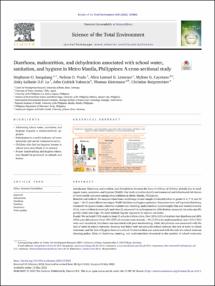Sangalang, Stephanie; Prado, Nelissa; Lemence, Allen Lemuel; Cayetano, Mylene; Lu, Jinky Leilanie; Valencia, John Cedrick; Kistemann, Thomas; Borgemeister, Christian: Diarrhoea, malnutrition, and dehydration associated with school water, sanitation, and hygiene in Metro Manila, Philippines : A cross-sectional study. In: Science of The Total Environment. 2022, vol. 838, part 2, no. 155882, 1-15.
Online-Ausgabe in bonndoc: https://hdl.handle.net/20.500.11811/10755
Online-Ausgabe in bonndoc: https://hdl.handle.net/20.500.11811/10755
@article{handle:20.500.11811/10755,
author = {{Stephanie Sangalang} and {Nelissa Prado} and {Allen Lemuel Lemence} and {Mylene Cayetano} and {Jinky Leilanie Lu} and {John Cedrick Valencia} and {Thomas Kistemann} and {Christian Borgemeister}},
title = {Diarrhoea, malnutrition, and dehydration associated with school water, sanitation, and hygiene in Metro Manila, Philippines : A cross-sectional study},
publisher = {Elsevier},
year = 2022,
month = sep,
journal = {Science of The Total Environment},
volume = 2022, vol. 838,
number = part 2, no. 155882,
pages = 1--15,
note = {Introduction Diarrhoea, malnutrition, and dehydration threaten the lives of millions of children globally due to inadequate water, sanitation, and hygiene (WaSH). Our study aimed to identify environmental and behavioural risk factors of these health outcomes among schoolchildren in Metro Manila, Philippines. Materials and methods We analysed data from a multistage cluster sample of schoolchildren in grades 5, 6, 7, 9, and 10 (ages ~10–15 years old) to investigate WaSH facilities and hygiene practices. Outcomes were: self-reported diarrhoea, measured via questionnaire; observed malnutrition (stunting, undernutrition [underweight/thin and wasted/severely thin], over-nutrition [overweight and obese]), measured via anthropometry; dehydration, measured via urine specific gravity/urine test strips. We used multiple logistic regression to explore correlates. Results We included 1558 students from 15 schools in three cities. Over 28% (421) of students had diarrhoea and 68% (956) were dehydrated. Over 15% (227) of students were stunted, ~9% (127) were undernourished, and >21% (321) were over-nourished. Diarrhoea was associated with poor handwashing, while dehydration was associated with the lack of water in school restrooms. Stunting was linked with not using the school restroom, the lack of water in school restrooms, and the lack of hygiene lessons in school. Undernutrition was associated with the lack of a school restroom cleaning policy. Risks of diarrhoea, stunting, and undernutrition decreased as the number of school restrooms increased. Risks of stunting and overnutrition decreased as the numbers of school toilets increased. Having more than seven handwashing basins was associated with decreased risk of dehydration. Discussion Findings from our cross-sectional study cannot describe causation. We have found associations that suggest that school restroom cleaning policies, adequate water supply, improved handwashing, and hygiene education are needed to prevent disease. School-based WaSH interventions are recommended to provide water in school WaSH facilities, promote handwashing, and improve hygiene-related knowledge.},
url = {https://hdl.handle.net/20.500.11811/10755}
}
author = {{Stephanie Sangalang} and {Nelissa Prado} and {Allen Lemuel Lemence} and {Mylene Cayetano} and {Jinky Leilanie Lu} and {John Cedrick Valencia} and {Thomas Kistemann} and {Christian Borgemeister}},
title = {Diarrhoea, malnutrition, and dehydration associated with school water, sanitation, and hygiene in Metro Manila, Philippines : A cross-sectional study},
publisher = {Elsevier},
year = 2022,
month = sep,
journal = {Science of The Total Environment},
volume = 2022, vol. 838,
number = part 2, no. 155882,
pages = 1--15,
note = {Introduction Diarrhoea, malnutrition, and dehydration threaten the lives of millions of children globally due to inadequate water, sanitation, and hygiene (WaSH). Our study aimed to identify environmental and behavioural risk factors of these health outcomes among schoolchildren in Metro Manila, Philippines. Materials and methods We analysed data from a multistage cluster sample of schoolchildren in grades 5, 6, 7, 9, and 10 (ages ~10–15 years old) to investigate WaSH facilities and hygiene practices. Outcomes were: self-reported diarrhoea, measured via questionnaire; observed malnutrition (stunting, undernutrition [underweight/thin and wasted/severely thin], over-nutrition [overweight and obese]), measured via anthropometry; dehydration, measured via urine specific gravity/urine test strips. We used multiple logistic regression to explore correlates. Results We included 1558 students from 15 schools in three cities. Over 28% (421) of students had diarrhoea and 68% (956) were dehydrated. Over 15% (227) of students were stunted, ~9% (127) were undernourished, and >21% (321) were over-nourished. Diarrhoea was associated with poor handwashing, while dehydration was associated with the lack of water in school restrooms. Stunting was linked with not using the school restroom, the lack of water in school restrooms, and the lack of hygiene lessons in school. Undernutrition was associated with the lack of a school restroom cleaning policy. Risks of diarrhoea, stunting, and undernutrition decreased as the number of school restrooms increased. Risks of stunting and overnutrition decreased as the numbers of school toilets increased. Having more than seven handwashing basins was associated with decreased risk of dehydration. Discussion Findings from our cross-sectional study cannot describe causation. We have found associations that suggest that school restroom cleaning policies, adequate water supply, improved handwashing, and hygiene education are needed to prevent disease. School-based WaSH interventions are recommended to provide water in school WaSH facilities, promote handwashing, and improve hygiene-related knowledge.},
url = {https://hdl.handle.net/20.500.11811/10755}
}






